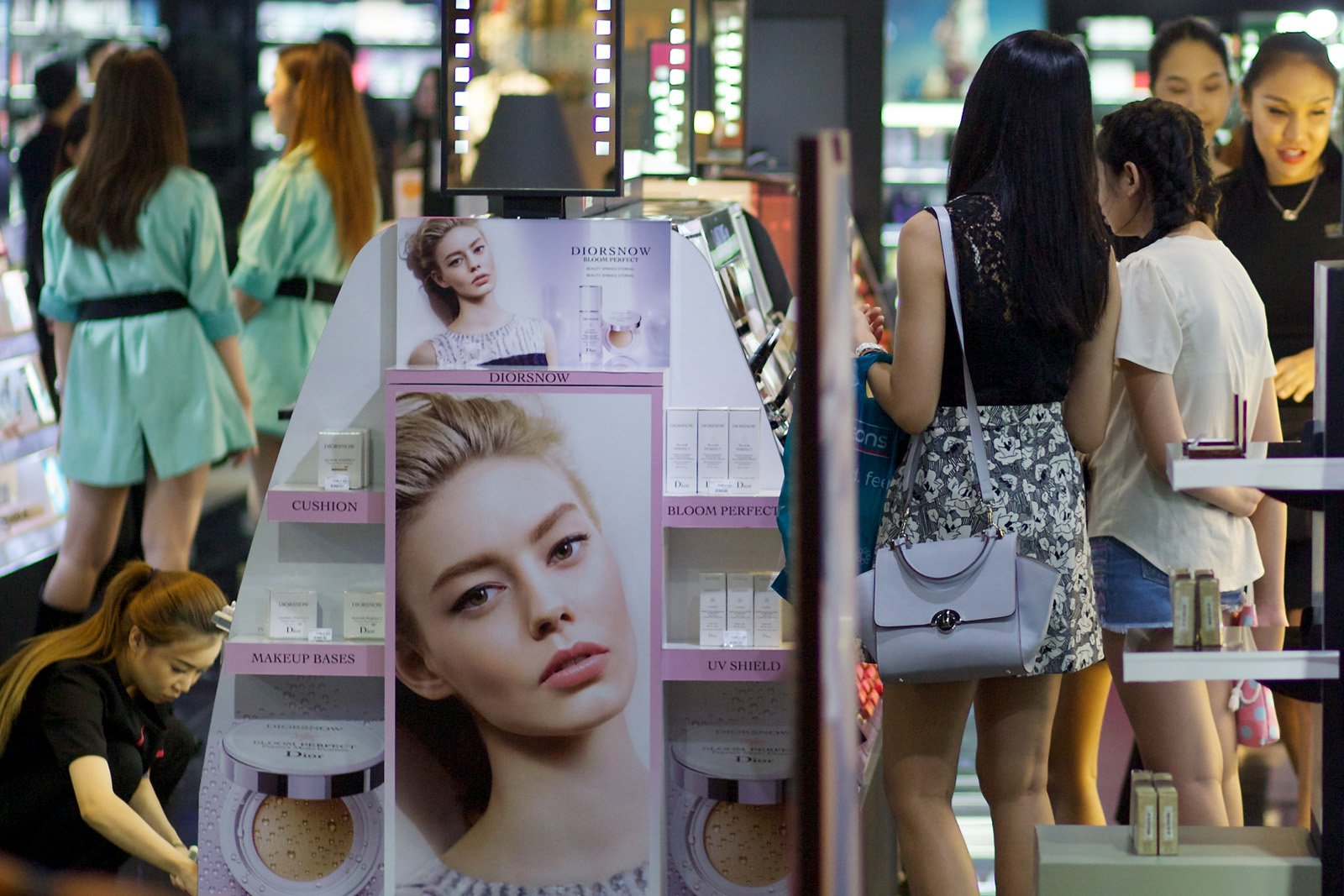So, Mr. Lewell, what first attracted you to a shop window full of bare legs?
That’s a bit like asking a young woman who’s just married a wealthy old man: what first attracted you to the billionaire Rupert XXXX (or whoever)? The question contains its own answer, but in both cases it may actually be wrong, or at least only partially true.
Speaking for myself, I was attracted by the way the various elements of the scene filled the picture frame right to the edges. True, the legs caught my eye, but so did the girl squatting down at the bottom left and the more distant view to the interior of the store where more people were moving around.
Far too many street photographs have dead space in the corners of their pictures.
Why am I not surprised? Because, for much of the time, the road and the sky have little visual interest. If you simply point your camera at an interesting subject, the chances are that you’ll end up taking lots of sky and lots of road. Please remember: they’re part of the picture, too.
If I get bare space (as opposed to bare legs) in the corners of the frame I have a nagging feeling that’s something’s not quite right.
Of course, like many street photographers, I have this feeling nearly every time — when one or another irritating imperfection reveals itself on close examination of the image. For example, there may be a lack of sharpness where sharpness would have been desirable. Or perhaps one part of the subject is hidden that would have looked better had it been revealed.
Yet the worst irritation is the appearance of dead space in areas surrounding the subject. I’ll do anything to avoid it.
I’m particularly fascinated by the concept of “layers,” on which I’ll have more to say as this blog develops. The above photo is a good demonstration of layers (or “planes of visual interest,” as I like to call them). In the foremost plane, the image is anchored by the curious double advert in which, hypnotically, the model’s face is repeated so that she gazes at us with four eyes instead of two.
As the image recedes, other layers cause the onlooker’s eye to “read” the photo by exploring it from one side to another. The girl with the shoulder bag is level with the point-of-sale display, so she is part of foreground and helps to balance the image. Beyond her are other women who are slightly foreshortened by the 85mm lens I was using. Black-belted sales assistants in turquoise uniforms fill the upper left of the image. There is no dead space.
The growing popularity of using layers in street photography is leading us towards more satisfying images. I am far from being their only exponent. I’m also exploring other techniques to fill the frame, not always successfully.
For example, there are many things wrong with this shot of a girl promoting a flavoured drink. For a start, it’s one of those quasi-street photographs I call “impromptu street portraits.” In other words, it’s not street photography at all, but a form of improvised portrait photography, undertaken without either the time or equipment to get it right. And I didn’t get it right.
I deliberately focused on her hand, expecting her face to be in acceptably sharp “soft” focus. I think I overdid it. In any case, there’s a suspicion of dead space at the bottom right which cannot be cropped without destroying the composition. I like the fact that the woman in red is glancing in our direction; that there are some products bottom left; that the blossom takes care of the top edge and corners. But the occluded face of the man in black and the obvious difference in sharpness between the subject’s hand and her face are aspects which ruin the image.
Typically, street photographers fill dead space in the foreground with out-of-focus figures and they fill similar space in the background with buildings and street furniture. Working with wide-angle lenses they keep much of the scene in sharp focus, thus avoiding the problems of bokeh (the quality of the out-of-focus areas).
Bringing every part of the frame into play tends to create a myriad of challenges for the street photographer. But surely that’s half the fun! It’s too easy to snap isolated subjects and ignore everything around them. In the same way, if you listen only to the violin in a violin concerto you’re not really hearing the whole work. It’s more difficult to follow several musical lines at once, but also more rewarding once you’ve learned how to do it.
As Walter Pater (1839–1894), essayist and art critic, said: “All art constantly aspires towards the condition of music.” It follows that there can be more than one instrument playing in a street photo.

